Territorial evolution of Australia
From Wikipedia, the free encyclopedia
The first colonies of the British Empire on the continent of Australia were the penal colony of New South Wales, founded in 1788, and the Swan River Colony (later renamed Western Australia), founded in 1829. Over the next few decades, the colonies of New Zealand, Queensland, South Australia, Van Diemen's Land (later renamed Tasmania), and Victoria were created from New South Wales, as well as an aborted Colony of North Australia. On 1 January 1901, these colonies, excepting New Zealand, became states in the Commonwealth of Australia. Since federation, the internal borders have remained mostly stable, except for the creation of some territories with limited self-government: the Northern Territory from South Australia, to govern the vast, sparsely populated centre of the country; the split of the Northern Territory into Central Australia and North Australia, and then the quick merger of those back into the Northern Territory; and the Australian Capital Territory, a federal district ceded from New South Wales.

Outside of the continent, Queensland attempted an expansion into New Guinea, but British authorities rejected this; the claim would later be made a British protectorate and ceded to Australia. The League of Nations mandated northeast New Guinea to Australia after World War I, as well as Nauru, which was placed under joint Australian-British-New Zealand jurisdiction. These mandates (and, later, United Nations trust territories) became the independent nations of Nauru and Papua New Guinea in the mid-20th century. Australia has also obtained several small island territories, mainly from earlier British colonies, and has a large claim on Antarctica.
Table of changes
Summarize
Perspective
Key to map colours
- Australian states
- Australian territories and founding colonies
- Area changed by event
Colonial period
| Date | Event | Map |
|---|---|---|
| 25 April 1787 | The Colony of New South Wales was created as a penal colony by the Kingdom of Great Britain in Australia east of 135° east.[1] Word of the establishment was proclaimed in Australia by Governor Arthur Phillip on 7 February 1788.[2] The commission included "all the islands adjacent in the Pacific Ocean" within the latitudes of 10°37' south and 43°39' south, which included most of New Zealand.[1] |  |
| 11 July 1810 | Macquarie Island was discovered by Frederick Hasselborough, who claimed it for the United Kingdom and declared it part of New South Wales.[3][4] |  |
| 16 July 1825 | New South Wales was extended west to 129° east, so that it would include a trading post set up on Melville Island; and the borders of the "islands adjacent in the Pacific Ocean" were moved north to 39°12' south, now including only a small part of New Zealand.[5] |  |
| 3 December 1825 | The southern islands of New South Wales were made the Colony of Van Diemen's Land.[6][7] |  |
| 2 May 1829 | A colony commonly known as the Swan River Colony was founded in the remainder of Australia outside of New South Wales.[8] Most documents calling for the colony's foundation make no mention of a name, apart from its location at the "Port on the Western Coast of New Holland, at the Mouth of the River called 'Swan River', with the adjacent Territory",[9] and that a settlement should be formed "within the Territory of 'Western Australia'".[10] However, the law calling for the creation of the colony does appear to specify that it should be called "Western Australia".[11] |  |
| 6 February 1832 | The legal instrument required to formally appoint James Stirling governor of the Colony of Western Australia was proclaimed, and this is commonly held as the date that the Swan River Colony was renamed Western Australia.[12][13] |  |
| 19 February 1836 | The portion of New South Wales between 132° east and 141° east, and south of 26° south, was made the Province of South Australia.[14] The actual landing and proclamation occurred on 28 December 1836.[15] Its border with New South Wales south of the Murray River would be erroneously surveyed roughly 3.6 kilometres (2.2 mi) west of 141° east, and the resulting disputes with the colonies and, later, states that share that border would not be fully resolved until 1914.[16] |  |
| 15 June 1839 | The islands of New Zealand were annexed to New South Wales.[17][18] The action was proclaimed on 14 January 1840.[19] |  |
| 16 November 1840 | The Colony of New Zealand was chartered and split from New South Wales.[20][21] |  |
| 26 September 1844 | Norfolk Island was transferred from New South Wales to Van Diemen's Land.[22] | 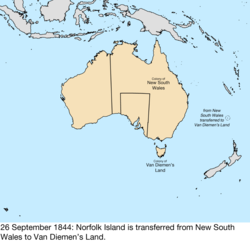 |
| 17 February 1846 | The half of New South Wales north of 26° south was made the Colony of North Australia.[23][24][25] |  |
| 28 December 1847 | Following a change in government in the United Kingdom, North Australia was merged back in to New South Wales.[23][25] This is the date Queen Victoria revoked the letters patent establishing North Australia, but it was not proclaimed in Australia until 16 January 1849. |  |
| 1 July 1851 | The portion of New South Wales south of the Murray River and a line from the headwaters of the river to Cape Howe was made the Colony of Victoria.[26] | 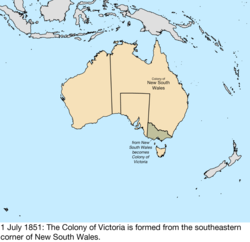 |
| 1 January 1856 | Van Diemen's Land was renamed Tasmania, as a way to get away from its past as a penal colony.[27] |  |
| 1 November 1856 | Norfolk Island was split from Tasmania, becoming its own colony.[28] Some sources say this occurred the previous day,[29] but the Norfolk Island Act 1913 states it was on this day. | 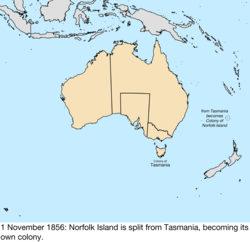 |
| 6 June 1859 | The portion of New South Wales north of 29° south, the Dumaresq and Macintyre Rivers, and several mountain ridges, and east of 141° east, was made the Colony of Queensland.[30] |  |
| 10 October 1861 | The portion of New South Wales west of South Australia was transferred to South Australia by letters patent. The act of parliament was passed on 22 July 1861.[31] |  |
| 13 March 1862 | The portion of New South Wales north of South Australia and east of 138° east was transferred to Queensland.[32] | 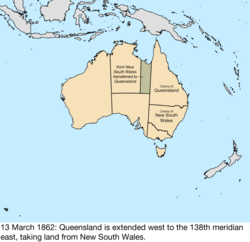 |
| 6 July 1863 | The region of New South Wales north of South Australia was transferred to South Australia.[33] |  |
| 30 May 1872 | All islands lying within 60 miles (97 km) of Queensland were annexed to the colony by letters patent.[34] This was done primarily to incorporate the Torres Strait Islands, which were starting to be claimed by New South Wales. It is unknown which specific islands may have already been considered part of Queensland, and the map included with the letters patent contained errors, such as including Melville Island in Queensland.[35] | too vague to map |
| 21 July 1879 | The Torres Strait Islands were specifically annexed to Queensland.[34][35] |  |
| 17 June 1880 | Macquarie Island was made a constituent part of the Colony of Tasmania through Letters Patent for the Governor of Tasmania.[36] |  |
| 4 April 1883 | Queensland claimed southeast New Guinea as a dependency, though the British government rejected the claim.[37] |  |
| 6 November 1884 | The British Empire declared southeast New Guinea as a protectorate, removing it from immediate Queensland control, though the colony still largely administered it.[38] | 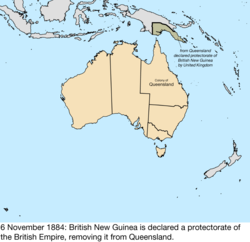 |
Federation
| Date | Event | Map |
|---|---|---|
| 1 January 1901 | Six colonies of the United Kingdom formed the Commonwealth of Australia:[39]
Parliament met in Melbourne until the federal capital could be built.[40] |
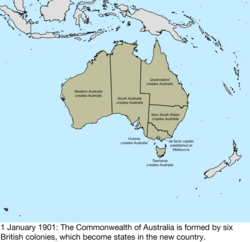 |
| 1 September 1906 | British New Guinea was transferred from the United Kingdom, becoming the Territory of Papua.[41][42] |  |
| 1 January 1911 | The Federal Capital Territory was split from New South Wales,[43][44] and the Northern Territory was split from South Australia.[45][46] While the acts creating it use the term "Territory for the Seat of Government", legislation and proclamations immediately began using the term "Federal Capital Territory."[47] | 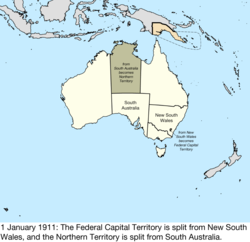 |
| 1 July 1914 | Norfolk Island was transferred from the United Kingdom, becoming the Territory of Norfolk Island.[28][48] |  |
| 4 September 1915 | A small peninsula along Jervis Bay was ceded to the Federal Capital Territory by New South Wales.[49][50] |  |
| 17 December 1920 | The League of Nations mandated the former German New Guinea to Australia as the Territory of New Guinea[51][52] and the Mandate of Nauru,[53][54] with New Zealand and the United Kingdom as co-trustees of Nauru.[55] |  |
| 1 February 1927 | The Northern Territory was split at 20° south into the territories of Central Australia and North Australia.[56][57] |  |
| 9 May 1927 | Parliament began meeting in Canberra, formally moving the capital there from Melbourne.[58][59] | 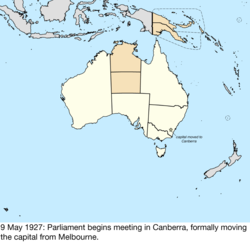 |
| 12 June 1931 | The territories of Central Australia and North Australia were merged to become the Northern Territory.[60][61] |  |
| 10 May 1934 | The Ashmore and Cartier Islands were transferred from the United Kingdom and became the Territory of Ashmore and Cartier Islands. A British order-in-council dated 23 July 1931 had stated that the islands would be placed under the authority of the Commonwealth of Australia when Australia passed legislation to accept them.[62][63] |  |
| 24 August 1936 | The United Kingdom transferred the portion of its claim to Antarctica between 45° east and 136° east, and 142° east and 160° east, to Australia, where it became the Australian Antarctic Territory.[64][65] | 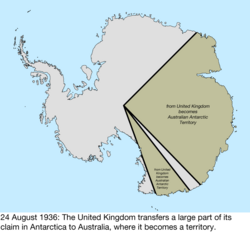 |
| 29 July 1938 | The Territory of Ashmore and Cartier Islands was annexed to the Northern Territory.[66]
The Federal Capital Territory was renamed the Australian Capital Territory.[67] |
 |
| 26 August 1942 | The Mandate of Nauru was captured by Japan.[68] |  |
| 14 September 1945 | The Japanese garrison in the Mandate of Nauru surrendered.[68] |  |
| 13 December 1946 | The Territory of New Guinea was reconstituted as a United Nations trust territory.[69] |  |
| 1 November 1947 | The Mandate of Nauru was reconstituted as the United Nations Trust Territory of Nauru.[69] |  |
| 26 December 1947 | Heard Island and McDonald Islands were transferred from the United Kingdom. The receipt was confirmed in letters exchanged on 19 December 1950.[70] |  |
| 1 July 1949 | The Territory of New Guinea and Territory of Papua were merged into the Territory of Papua and New Guinea, mainly for administrative purposes; the act makes it clear that the identities of New Guinea as a United Nations Trust Territory and Papua as a possession of the Crown remain intact.[71][72] | 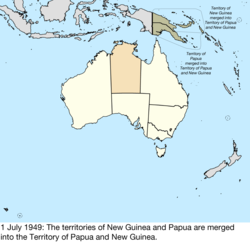 |
| 24 April 1953 | Heard Island and McDonald Islands were formally declared the Territory of Heard Island and McDonald Islands.[73] |  |
| 23 November 1955 | The Cocos (Keeling) Islands were transferred by the United Kingdom from the Colony of Singapore, becoming the Territory of the Cocos (Keeling) Islands.[74][75] | 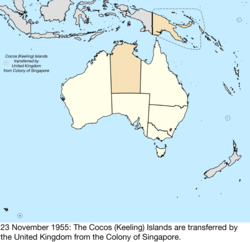 |
| 1 October 1958 | Christmas Island was transferred by the United Kingdom from the Colony of Singapore, becoming the Territory of Christmas Island.[76][77] |  |
| 31 January 1968 | The Trust Territory of Nauru became independent as the Republic of Nauru.[78][79] |  |
| 30 September 1969 | The Coral Sea Islands Territory was created from Queensland.[80] |  |
| 27 December 1971 | The Territory of Papua and New Guinea was renamed Papua New Guinea.[81] | 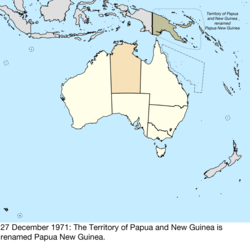 |
| 31 December 1973 | The peninsula along Jervis Bay belonging to the Australian Capital Territory was formally named the Jervis Bay Territory; at this time, it was still considered part of the ACT.[82] | no change to map |
| 11 September 1975 | The Republic of the North Solomons declared the independence of the region surrounding Bougainville Island in Papua New Guinea.[83] |  |
| 16 September 1975 | Papua New Guinea became independent as the Independent State of Papua New Guinea,[84] rendering the dispute with the Republic of the North Solomons moot. |  |
| 1 July 1978 | The Ashmore and Cartier Islands were split from the Northern Territory, becoming the Territory of Ashmore and Cartier Islands.[85] |  |
| 3 March 1986 | The Australia Act 1986 made Australia completely independent of the United Kingdom.[86] | no change to map |
| 11 May 1989 | Jervis Bay Territory was split from the Australian Capital Territory to become its own territory.[87] |  |
| 7 July 1997 | Elizabeth Reef and Middleton Reef were transferred from New South Wales to the Coral Sea Islands Territory.[88] |  |
Proposed boundary change to the Australian Capital Territory
In September 2022, it was announced the border between the Australian Capital Territory and New South Wales would change for the first time since it was created in 1911.[89] ACT chief minister Andrew Barr said NSW premier Dominic Perrottet had agreed to a proposed border change for 330 hectares of land.[90]
See also
References
External links
Wikiwand - on
Seamless Wikipedia browsing. On steroids.
